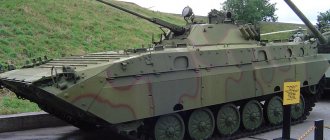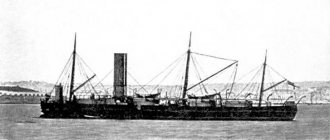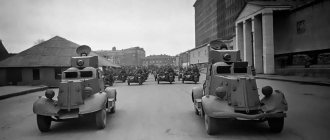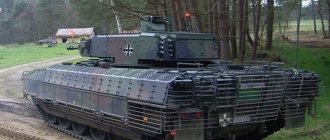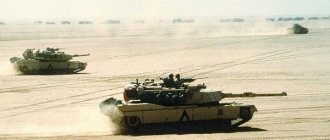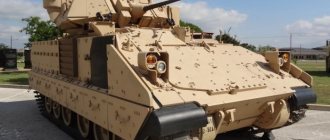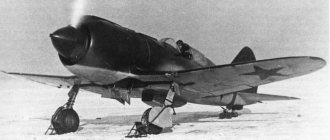YaMZ is stronger than Scania
At the Boomerang base, only an armored personnel carrier with a machine gun was shown. But the height of the car and its characteristic dimensions literally screamed - not a modification, but a fundamental novelty!
Boomerang with a cannon in an uninhabited tower.
Boomerang with a cannon in an uninhabited tower.
What is called AMV abroad is given the abbreviation UBP - universal combat platform. This does not change the essence, Boomerang is a domestic modular wheeled vehicle. They promise to soon put the vehicle into service, but now it is at the stage of prototypes, tests, and test operation among the troops. Perhaps something else in the design will be changed, but we can safely say that the Boomerang will be in demand by our army and it has good export prospects.
Those first combat vehicles entered the parade with 510-horsepower Barnaul diesel engines UTD-32. Even then, in terms of power supply, they were not inferior to the Finnish Patria. And now a new turbodiesel YaMZ-780 has been developed for Boomerangs. Look at the technical specifications table - domestic inline six with 750 hp. will put both Scania modifications to shame. But the Boomerang is not only strong in its power supply. From the same table it is clear that the domestic new product does not lose to Patria in any position.
Boomerang with a cannon in an uninhabited tower. |
The maximum speed of the Boomerang is 100 km/h. |
Is a low pelvis pleasing to the eye?
Skeptics still doubt the usefulness of a wheeled armored personnel carrier with dimensions slightly inferior to the Armata. They say that even an elderly Volkssturm soldier with cataracts and a first-model Panzerfaust will not miss such a “barn.” At night. Moonless. In a snowstorm.
Are dimensions really that critical for a combat vehicle in the first quarter of the 21st century?
A little history. The main wheeled armored personnel carrier of the Russian army, the BTR-80/82, traces its ancestry directly to the BTR-60. At first, the four-axle vehicle satisfied the parameters of the Cold War doctrine (not the BTR-152, which is already good) - transporting soldiers to the battlefield at a decent speed, protecting them from flying shrapnel or machine-gun fire from an ambush. Many solutions were compromises: pairing car engines from the 51st “lawn” (there was not a sufficiently compact and powerful one at hand); thin armor 5-9 mm, but at rational angles of inclination; open top.
Then they thought that sparkling helmets against the backdrop of bright “mushrooms” from explosions of nuclear charges was not very good for the health of Soviet motorized riflemen. Therefore, they made a roof and a turret for twin machine guns (BTR-60PB). All this is dictated by the needs of a massive multi-million army and the capabilities of industry.
But what were advantages became disadvantages over the years. Thin armor and fire-hazardous gasoline engines already played their fatal role in Afghanistan. The growing mine war forced the infantry to climb onto the roof. When a mine explodes, there is a chance that you will fly to the side, and in a cramped iron box - certain death.
Sniper bullets? Neglect! Mines are worse
And no matter how you modernize the armored personnel carriers of this family, installing a diesel engine, adding 30-mm cannons, thickening (slightly) the armor, introducing anti-fragmentation lining and modern aiming and observation means, in hot spots Russian soldiers on the march will invariably climb onto the armor.
BTR-80, BTR-82, BTR-82AM, BTR-82AT - no matter how many letters you put on the index, vehicles of this family are obsolete and are not suitable for the conditions and tasks of modern wars. In short, countless modernizations lead to a dead end.
Syria. It’s more familiar on armor, but is it safer?
The new generation vehicle allows us to provide a different level of protection, both from mines and from small arms and even from large-caliber machine guns and automatic cannons. And now they strive to install a large caliber on every rusty pickup truck. The BTR-82 simply cannot provide protection against them. What can I say: it hits the side and an armor-piercing rifle bullet from medium distance is no longer very good.
Barn? No, we haven't heard. Armored personnel carrier Vilkas (nee "Boxer") of the Lithuanian army
It’s just easier to get into an armored personnel carrier from an autocannon or DShK than from a grenade launcher. Let us recall the tabular and practical indicators of the firing range of the RPG-7. What about a moving target? This is truly a sniper and filigree work, for which you still need to seriously shine the carcass from behind cover.
For modern high-precision weapons, gaining a couple of tens of centimeters in size means almost nothing. And optical-electronic suppression, dynamic protection and active protection systems (APS) can save you from being hit by ATGMs. In the development of the latter, unfortunately, Russia is losing the palm - in the West, KAZs are actively being developed and are planning to be installed almost on trucks. Recently, the US Army took two systems - Israeli and German origin - for comparative tests for subsequent equipping with them various types of armored vehicles.
On the BTR-82, a V-shaped mine-resistant bottom will not work, but on the Boomerang it will work. The same thing - a suspended floor and energy-absorbing chairs for paratroopers with shock absorption and individual suspension.
In conditions when 70% of the losses of regular armies in local conflicts are due to mines and IEDs, this is a necessity.
The Boomerang finally got rid of one of the main problems of Soviet armored personnel carriers - the lack of a stern outlet. Doors on the sides and hatches on the roof clearly never contributed to a safe landing. And sometimes the vehicle itself has to provide a weak side to cover motorized riflemen.
Options [edit]
The VPK-7829 Bumerang is called a "wheeled combat vehicle" because it will perform several different roles, similar to the American Strykers. Other vehicle platform variants will serve a variety of roles in addition to armored transport, including as an armored ambulance, command post vehicle, reconnaissance vehicle, anti-tank missile carrier, air defense launcher, fire support vehicle and mortars. [7] Further versions may include a light tank [11] (plans for a version with a 57 mm automatic gun, as well as a version with a 125 mm gun for use as a self-propelled anti-tank gun were confirmed in March 2022) [13] and self-propelled gun. [9]
- BTR-7829 K-16 Boomerang - APC version with a remote weapon station with an easel 12.7mm cannon.
- VPK-7829 K-17 Boomerang is an infantry fighting vehicle variant with a 30 mm or 57 mm automatic cannon.
- Self-propelled anti-tank gun variant.
Features of the “Boomerang” armored personnel carrier
One of the main advantages, and at the same time disadvantage of the vehicle, is its armor. The designers reduced the number of steel sheets in the body of the armored personnel carrier, replacing them with ceramic plates. Ceramics are much lighter than steel; this substitution provided the Boomerang with greater mobility. The vehicle, with relatively less weight, has significantly increased its speed and maneuverability.
Skeptics, in turn, insist that the use of ceramic blocks eliminates the possibility of field repair of the vehicle: when a projectile hits a ceramic plate, it dampens the inertia of the shot over its entire area. Such shaking leads to material fatigue and failure. It is not possible to replace ceramic shields in the field. When choosing between reliability and agility, more votes go for reliability. However, dissatisfaction with ceramics is purely conditional. The designers prudently made the armor removable. If desired, ceramic sheets can be replaced with classic steel.
Photo from https://ru.wikipedia.org/wiki/%D0%91%D1%83%D0%BC%D0%B5%D1%80%D0%B0%D0%BD%D0%B3_(%D0% BA%D0%BE%D0%BB%D1%91%D1%81%D0%BD%D0%B0%D1%8F_%D0%BF%D0%BB%D0%B0%D1%82%D1%84% D0%BE%D1%80%D0%BC%D0%B0)
Floating armored personnel carrier
The presence of two symmetrically located water cannons in the rear of the vehicle indicates the vehicle’s ability to overcome water obstacles
This quality is very important in the conditions of local tactical operations, during which the establishment of crossings is difficult or can unmask the direction of the main attack, and the capture of bridges is not always justified. “Navigating” qualities can be very useful during sea or river landings, especially if the landing craft cannot come close to the shore
It is not known for certain what speed the water cannons impart to the Boomerang armored personnel carrier; representatives of the design bureau limit themselves to the definition of “not bad.”
Where to go
Many experts, by the way, criticize the very concept of a wheeled (and generally light) tank as applied to the Russian armed forces. At the same time, there are opinions that such equipment would be useful in modern maneuver warfare in open spaces against an enemy lagging behind by several phases of development - as in Syria with its endless “Toyota wars” and kamikaze vehicles.
To what extent such a machine is generally needed in the modern weapons system of the ground forces is, of course, up to the Ministry of Defense to decide. In any case, it should be noted that the theme of a wheeled tank based on the Boomerang has at least some chance of development only after the adoption of priority models created on this platform: the already mentioned K-17 BMP and K-16 armored personnel carrier.
Boomerang
BMP "Boomerang"
Photo: IZVESTIA/Alexey Mayshev
Of course, there is a place for a vehicle of this class in the global arms market. But it is easy to see that this market, which has a limited volume, is already overstocked. In addition to old models, such as the French AMX-10RC or the Brazilian Cascavel (especially popular in the Third World), new models of equipment are putting pressure on the market: the already mentioned Centauro, as well as American vehicles on the Stryker platform. At the same time, the countries that are potentially most interested in such a tank are the least solvent - these are the poor states of Africa and South Asia.
Two and a Half Diggers
Another point that is traditionally treated with disdain in both the USSR and Russia is ergonomics.
If you compare a Soviet motorized rifleman from the 60-70s and a modern fighter in the “Warrior” kit, it is easy to notice that a soldier of the 21st century carries more equipment, which means that the volume of the fighting compartment is required more. And a modern officer or contract soldier (which is two-thirds of the army) will be heavier than an 18-year-old conscript.
Let’s not mention here the armor of modern sappers and fighters of the assault and barrage battalions - it’s just the ultramarines from Warhammer resting there.
Help the soldiers of the assault and clearing battalion get into the BTR-82A (photo: Grigory Milenin)
Even if we push in all this body-positive brethren, will the soldiers reach the battlefield in sufficient physical condition for battle? Hardly. This is a worldwide problem and they solve it with more spacious, and therefore larger, equipment like the same American “strikers” (which have already undergone several modernizations, increased in size and almost doubled in weight), German “boxers”, Italian “Frecchia” and so on Further. A modern motorized infantry squad is heavier, more protected, and has more teeth in its weapons. There are never too many cartridges and grenades either.
Where did the idea for K-17 come from? A new class of infantry fighting vehicles based on the Boomerang - background
Representatives of the country's military-industrial complex want to please everyone - the Russian army and the armies of foreign countries that adhere to NATO standards. At first, the project was a joint one with the French Renault, then the United States imposed sanctions against the Russian Federation - as a result: the K-17 BMP became only Russian, on which 40 Russian enterprises worked. The project retained the unusual NATO dimensions in height and length of the body, as well as heavy armor.
A simplified modification can be sold, which will save the 2022 rearmament program, and, therefore, will not stop the strengthening of the state’s defense capability due to some lack of money. Now we have to borrow from the same NATO, which since 2003 has been supplying the US Army with Strikes similar to the Boomerang, followed by the Germans. The Italians, French and other countries of the alliance are arming themselves with their own or allied similar equipment. We have to catch up in quantity and surpass in quality. The difference between the Russian Federation and NATO in class will grow.
In an interview with journalists, the director of VPK LLC, Dmitry Galkin, said that the Boomerang is not an armored personnel carrier, but a medium platform on wheels for armored personnel carriers, infantry fighting vehicles and tanks. He noted that this is not about modernizing the BTR-90 prototypes, but about creating a completely new combat unit. Logistics and technical support transport will also be installed on this platform in the near future. The project from VPK LLC VPK-7829, now known as the K-17 BMP, will be produced at the Arzamas Machine Plant. The military first became aware of it in 2013 at the closed exhibition RussiaArmsEXPO, and the public saw the K-17 Boomerang BMP at the Victory Parade on 05/09/2015.
Read Armored personnel carrier BTR D
The Russian military wants to see the Boomerang floating, which means that a technical limitation is established in the hull armor and in the choice of weapons, because then the mass of the vehicle cannot be exceeded - 25 tons. This became the cause of disputes with the Minister of Defense of the Russian Federation, as well as the desire of our officers to install loopholes, which also reduces the protection of the crew and paratroopers with armor. Therefore, the armor is made removable, divided into light, medium and heavy; quality has been improved due to multi-layering and the use of ceramics.
Radical technical and ideological changes
Traditionally, Russian designers of military equipment rely on the experience accumulated during the Soviet years. However, this time the usual system was rejected from the very beginning. In the 90s, work was carried out to create a new armored personnel carrier "Rostok" (BTR-90), which was a deep modernization of the BTR-82, but the leadership of the Ministry of Defense was not impressed with the results. The project was called "Sleeve". The engine was supposed to be placed in the middle of the car, the internal space remained cramped, and the modification potential of the sample was extremely limited. Work on the BTR-90 was stopped, but they decided to transfer some successful solutions to the new Boomerang project. The armored personnel carrier, however, had to be practically created anew, completely reviewing the entire ideology and architecture of the combat vehicle.

